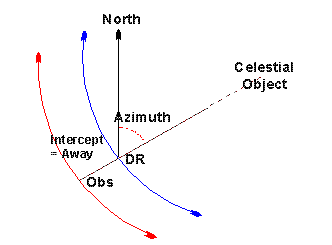Sun's Information and Sight Reduction
Below is a form using JavaScript that provides the Sun's information and sight reduction
- for the years between 1979 and 2020. Please note that inputs with leading zeros will cause errors when processed by this script.
[The error for GHA and Declination of Sun calculated by this script in most of
the cases should not exceed 0.3' which is considered as very small when compared
with the accuracy of human observation by marine sextant.]
I wish to thank Oscar W. Underwood III, a retired American engineer, for information he provided that
enable me to extend my Sight Reduction program from the year 2000 through 2020.
The Intercept (Marcq Saint-Hilaire) Method
Sun sights during the daylight hours and stars sights during twilight are obtained to
determine the ship's position. The Marcq Saint-Hilaire or intercept method is the most
popular way to reduce a sight for a line of position.
The intercept method uses the difference between the observed true altitude (obtained by
correcting the sextant altitude for index error, reflection, dip, etc) and the
calculated altitude (obtained by sight reduction tables or calculations) of the ship's
DR position to give an intercept for plotting the line of position on chart
or plotting sheets.
The result of a sight provides us with the following information :-
The article in the general sight reduction script briefly describes
the history of navigation by celestial observations. The practice of position fixing by
celestial bodies has been used by navigators in ocean passage until accurate and
low cost electronic navigation aids, like transit satellite and GPS, are available.
 The figure on the right shows the principle of the intercept method. If we take the
celestial body as the centre of a circle, the position circle formed by using the zenith
distance (90 degrees - altitude) of the calculated altitude as radius will pass through
the DR position and that for the observed true altitude should pass through the
observer's position. Given that the celestial bodies are so far away from the earth, we
can safely assume that the arc of these position circles passing the observer's
vicinity are in straight lines. These position lines are running prependicular to the Azimuth
of the celestial body concerned.
The figure on the right shows the principle of the intercept method. If we take the
celestial body as the centre of a circle, the position circle formed by using the zenith
distance (90 degrees - altitude) of the calculated altitude as radius will pass through
the DR position and that for the observed true altitude should pass through the
observer's position. Given that the celestial bodies are so far away from the earth, we
can safely assume that the arc of these position circles passing the observer's
vicinity are in straight lines. These position lines are running prependicular to the Azimuth
of the celestial body concerned.
The intercept as measured from the DR position is therefore the difference between the true and
calculated altitudes. It should be plotted towards the body's azimuth if the true altitude is
greater than the calculated altitude.
To make the above simple
The practice of reducing a sight to a line of position is summerized as below :-
 [ Home ?
[ Home ? ]